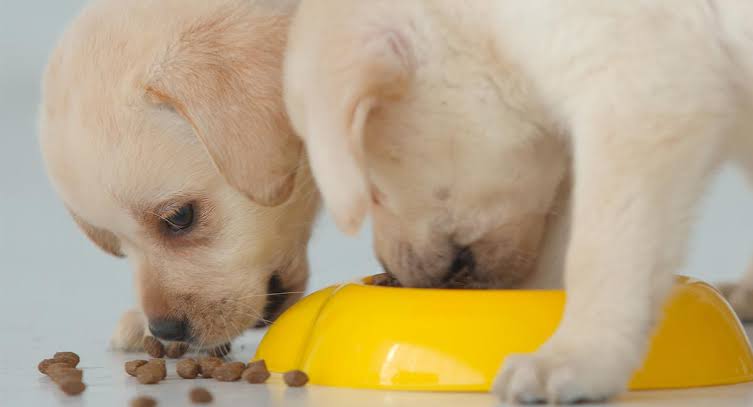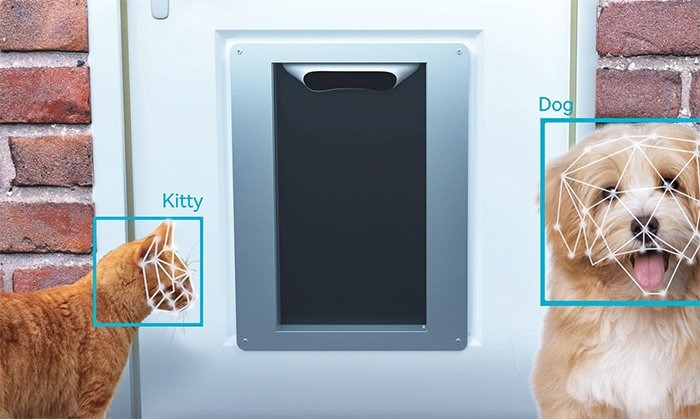
Feeding Guide for Labrador Puppies: Nutrition Tips & Meal Schedule
Proper nutrition is essential for Labrador puppies’ growth and development. Feeding them a balanced diet of quality puppy food, appropriate meal frequency, and controlled portions supports their health. Avoid toxic foods and provide fresh water constantly. Treats should be limited. Transition to adult food around one year, with vet guidance. Consulting a veterinarian ensures the best dietary plan tailored for your puppy’s unique needs and promotes a strong, healthy future.
🐶 Pet Star
40 min read · 3, Jun 2025

Introduction
Bringing a Labrador puppy into your home is an exciting and rewarding experience. Labradors are known for their friendly nature, intelligence, and boundless energy, making them one of the most popular dog breeds worldwide. However, ensuring that your Labrador puppy grows up healthy and strong requires proper nutrition and a well-structured feeding routine.
Feeding a Labrador puppy is not just about filling their bowl; it involves providing balanced, high-quality nutrition tailored to their growth stages and activity levels. Puppies have unique dietary needs compared to adult dogs, as their bodies are rapidly developing bones, muscles, and organs. Proper nutrition supports optimal growth, strengthens the immune system, and helps prevent future health problems such as obesity and joint issues, which Labradors are prone to.
This comprehensive feeding guide covers essential nutrition tips, explains what to feed your Labrador puppy, and provides a practical meal schedule to keep your furry friend happy and healthy from the very start. Feeding a Labrador puppy correctly is arguably one of the most critical foundational elements for their lifelong health, development, and temperament, extending far beyond simply filling a bowl with kibble. It's a precise science and an art, demanding a deep understanding of their rapid growth phases, specific nutritional requirements as a large breed, their notoriously ravenous appetite, and the importance of establishing a consistent, balanced meal schedule. Labradors are prone to rapid growth, which, if improperly managed through diet, can lead to serious skeletal and joint issues like hip and elbow dysplasia later in life. Their inherent love for food also means they are highly susceptible to overfeeding and subsequent obesity, a condition that can exacerbate joint problems and significantly shorten their lifespan. Therefore, a comprehensive feeding guide for a Labrador puppy is not just about what to feed, but how much, when, and with what considerations, laying the groundwork for strong bones, healthy muscles, a vibrant coat, and a well-regulated metabolism that supports their active lifestyle. This guide emphasizes large-breed specific nutrition, proper portion control, consistent meal schedules, and the judicious use of treats, all while prioritizing regular veterinary consultation.
The cornerstone of a healthy feeding regimen for a Labrador puppy is selecting a high-quality, large-breed puppy formula. This is not merely a marketing gimmick; large-breed puppy foods are specifically formulated with a controlled calcium-to-phosphorus ratio and a slightly lower caloric density and protein content compared to standard puppy foods. This meticulous balance is crucial for promoting slow and steady growth of bones and joints, preventing the rapid growth spurts that can predispose Labradors to developmental orthopedic diseases. Look for brands that list real meat (e.g., chicken, lamb, salmon) as the first ingredient, followed by whole grains or easily digestible carbohydrates (e.g., brown rice, barley, sweet potato), and healthy fats. Avoid foods with excessive fillers, artificial colors, flavors, or preservatives. The packaging should clearly state that the food meets the nutritional levels established by the Association of American Feed Control Officials (AAFCO) for growth and development, specifically for large breed puppies. While grain-free diets have gained popularity, current veterinary consensus suggests that for most puppies, grains are not harmful and often provide essential nutrients; consult your vet before opting for a grain-free formula due to potential links to dilated cardiomyopathy in some breeds.
Once the right food is chosen, portion control becomes the next most critical aspect. Labrador puppies have a remarkable ability to act perpetually hungry, making it easy for well-meaning owners to overfeed. Overfeeding, even with a large-breed formula, leads to excessive weight gain and rapid growth, increasing the risk of orthopedic issues. The feeding guidelines provided on the food packaging serve as a starting point, but they are just that – a guide. These recommendations are based on an average puppy's needs and often cover a wide weight range. Factors such as the puppy's individual metabolism, activity level, and growth rate will influence their actual caloric requirements. It is crucial to monitor your puppy's body condition score (BCS) regularly. You should be able to easily feel, but not visibly see, their ribs. They should have a defined waist when viewed from above and a tucked-up abdomen when viewed from the side. If you can see their ribs, they might be too thin; if you can't feel them easily, they might be overweight. Adjust food portions incrementally (e.g., by 1/4 cup) based on their BCS and energy level. Your veterinarian is your best resource for personalized portion recommendations and for assessing your puppy's ideal weight and growth trajectory during regular check-ups.
Establishing a consistent meal schedule is vital for a Labrador puppy's digestive health, house-training, and overall routine. For young puppies (8-12 weeks), 3-4 meals per day are typically recommended to support their rapid growth and smaller stomach capacity. As they grow (3-6 months), this can usually be reduced to 3 meals per day. By 6-12 months, most Labrador puppies can transition to 2 meals per day, which is the standard for adult dogs. Feeding at the same times each day helps regulate their metabolism, aids in predicting potty breaks, and minimizes digestive upset. Avoid free-feeding (leaving food out all day), as this can lead to overeating, makes house-training more difficult, and prevents you from monitoring their appetite, which can be an early indicator of illness. Instead, put the food down for 15-20 minutes, and if they don't eat it, pick it up until the next scheduled meal. This teaches them to eat when food is available and reinforces your role as the provider. Consistency in the feeding schedule also provides a sense of security and predictability, which is beneficial for a young puppy's emotional development.
Treats can be a valuable tool for training and bonding, but they must be used judiciously, especially with a Labrador puppy. Treats should constitute no more than 10% of their daily caloric intake to prevent overfeeding and ensure they still get most of their nutrients from their balanced puppy food. Opt for small, low-calorie training treats or even use small pieces of their regular kibble as rewards. Avoid human "junk food" or anything high in sugar, salt, or unhealthy fats. Be mindful of food allergies or sensitivities when introducing new treats. For mental stimulation and to manage their high energy, consider using puzzle toys or KONGs stuffed with a small portion of their daily kibble or a vet-approved spread (like plain pumpkin puree or unsweetened applesauce). This makes mealtime an enriching activity rather than just a quick gulp.
Beyond these core principles, there are other important considerations. Transitioning food should always be done gradually over 7-10 days to avoid digestive upset. Mix a small amount of the new food with the old, slowly increasing the proportion of new food each day until the puppy is fully on the new diet. Avoid sudden changes. Always provide constant access to fresh, clean water. Labradors are active and can become dehydrated quickly, especially during play or warmer weather. Ensure water bowls are always full and clean. Finally, regular veterinary check-ups are essential. Your vet can monitor your puppy's growth rate, assess their body condition, provide specific dietary recommendations based on their individual needs, and advise on when to transition from puppy food to adult dog food (typically between 12-18 months for large breeds, but can vary). They can also address any concerns about allergies, sensitivities, or digestive issues.
In conclusion, a meticulous feeding guide for a Labrador puppy is foundational for nurturing a healthy, well-adjusted, and long-lived companion. It demands a deliberate choice of high-quality, large-breed specific puppy food, rigorous portion control to prevent rapid growth and obesity, and the unwavering establishment of a consistent meal schedule that caters to their developmental stages. The judicious use of treats, ample fresh water, and a gradual transition between foods further solidify these practices. Ultimately, successful feeding transcends mere sustenance; it's a profound commitment to understanding their breed-specific needs and continually monitoring their progress with the expert guidance of a veterinarian. By adhering to these principles, owners can confidently lay the nutritional groundwork for their Labrador puppy to grow into a robust, energetic, and cherished member of the family, minimizing health risks and maximizing their potential for a vibrant life.
Understanding the Nutritional Needs of Labrador Puppies
Labrador puppies have specific nutritional requirements that differ significantly from adult dogs or other breeds. Meeting these needs is crucial for their development and long-term health.
Key Nutrients for Growth
- Protein: Essential for muscle development and tissue repair. Labrador puppies need higher protein levels (22-30%) compared to adult dogs.
- Fats: Provide concentrated energy and support brain development. Healthy fats such as omega-3 and omega-6 fatty acids are important for coat health and immune function.
- Carbohydrates: Supply energy but should come from quality sources like whole grains and vegetables, not fillers.
- Calcium and Phosphorus: Critical for healthy bone and teeth development. The correct balance is vital to prevent skeletal problems.
- Vitamins and Minerals: Support overall bodily functions, including vision, skin, and immune health.
- Water: Adequate hydration is necessary at all times, especially in active puppies.
Avoiding Overfeeding and Obesity
Labradors are naturally enthusiastic eaters and can easily become overweight if their diet isn’t managed well. Excess weight puts stress on their growing joints, leading to arthritis and mobility issues. Overfeeding or giving too many treats can cause obesity, so portion control and feeding schedules are important.
Choosing the Right Food for Your Labrador Puppy
Commercial Puppy Foods
There are many high-quality commercial puppy foods designed to meet the nutritional needs of growing Labradors. Look for brands that:
- List real meat as the first ingredient
- Are specifically formulated for large breed puppies
- Contain balanced ratios of protein, fats, vitamins, and minerals
- Avoid artificial preservatives, colors, and fillers
Large breed puppy formulas help regulate growth to prevent rapid weight gain that can harm joints.
Homemade and Raw Diets
Some owners prefer homemade meals or raw feeding, but these require careful planning to ensure the puppy receives balanced nutrition. Consult a vet or canine nutritionist before starting any alternative diets.
Foods to Avoid
- Chocolate, caffeine, grapes, and raisins
- Onions, garlic, and chives
- Cooked bones
- Excessive dairy products
- Foods high in fat and salt
These can cause digestive upset, toxicity, or other health issues.
Feeding Schedule for Labrador Puppies
The timing and frequency of meals play a crucial role in your puppy’s digestion, energy levels, and behavior.
Age-Wise Feeding Guide
6 to 12 Weeks Old
- Feed 4 meals per day
- Use a high-quality puppy food suitable for large breeds
- Portion sizes: Follow the packaging guidelines but watch for signs of hunger or fullness
- Avoid overfeeding to prevent digestive issues
3 to 6 Months Old
- Feed 3 meals per day
- Increase portion size gradually as puppy grows
- Monitor weight and adjust food quantity accordingly
6 to 12 Months Old
- Feed 2 to 3 meals per day
- Transition gradually to adult food at around 12 months or as advised by your vet
- Keep an eye on energy levels and body condition
Portion Control and Monitoring Growth
It’s essential to weigh and measure food portions to avoid overfeeding. Labradors can gain weight quickly, so keep track of your puppy’s weight weekly. Your vet can help determine ideal weight ranges and recommend portion adjustments.
Look for:
- A visible waist when viewed from above
- Ribs that can be felt but not seen prominently
- Healthy energy levels and coat condition
If your puppy is gaining weight too quickly, reduce portions or increase play and exercise.
Hydration: The Unsung Hero
Water is as important as food. Make sure your puppy always has access to fresh, clean water throughout the day. Proper hydration aids digestion and keeps your puppy’s body functioning well.
Treats and Supplements
Treats are great for training but should be given in moderation. Choose healthy, low-calorie treats that contribute to your puppy’s nutrition. Avoid human snacks, and never replace meals with treats.
Supplements such as omega-3 fatty acids, glucosamine, or probiotics may be beneficial but should only be given after consulting your vet.
Common Feeding Mistakes to Avoid
- Free-feeding (leaving food out all day) which encourages overeating
- Feeding adult dog food too early
- Ignoring weight gain or loss signs
- Giving too many table scraps or treats
- Abrupt diet changes without transition periods
Tips for a Smooth Feeding Routine
- Create a quiet, comfortable eating area
- Keep feeding times consistent
- Use measured bowls to control portions
- Avoid feeding right before or after vigorous exercise
- Watch for any digestive issues like diarrhea or vomiting
Conclusion
Feeding your Labrador puppy the right way is one of the most important responsibilities you have as a pet owner. By providing balanced nutrition, following a structured feeding schedule, and monitoring their growth, you ensure that your puppy develops into a healthy and happy adult dog. Remember, quality food, proper portions, and consistency are key to supporting your Labrador’s energetic lifestyle and preventing common health issues. Always consult your veterinarian for personalized advice tailored to your puppy’s needs.
With patience and care, you’ll build a strong foundation for your Labrador’s lifelong health — starting from those crucial early months.
Q&A Section
Q1: What are the basic nutritional needs of Labrador puppies?
Ans: Labrador puppies need a balanced diet rich in proteins, fats, vitamins, and minerals to support their rapid growth and energy needs.
Q2: How often should I feed a Labrador puppy?
Ans: Typically, puppies up to 3 months old should be fed 4 times a day. From 3 to 6 months, 3 meals daily, then twice daily after 6 months.
Q3: What types of food are best for Labrador puppies?
Ans: High-quality commercial puppy food formulated for large breeds, combined with occasional fresh meats, vegetables, and grains, ensures balanced nutrition.
Q4: Can I feed homemade food to my Labrador puppy?
Ans: Yes, but homemade meals should be well-balanced and include proteins, carbs, fats, and essential nutrients. Consulting a vet for recipes is recommended.
Q5: How much food should a Labrador puppy eat?
Ans: The amount depends on the puppy’s age and weight. On average, 1.5 to 3 cups of food daily, divided into meals, adjusted as the puppy grows.
Q6: Are treats good for Labrador puppies?
Ans: Treats are okay in moderation but should not exceed 10% of their daily calorie intake to avoid unhealthy weight gain.
Q7: What foods should be avoided for Labrador puppies?
Ans: Avoid chocolate, onions, garlic, grapes, raisins, caffeine, and overly fatty or spicy foods as they can be toxic or harmful.
Q8: When can I switch my Labrador puppy to adult dog food?
Ans: Generally, around 12 months of age, when their growth slows, but always consult your vet before transitioning.
Q9: How important is water for Labrador puppies?
Ans: Fresh water should be available at all times to keep puppies hydrated and support overall health.
Q10: Should I consult a vet for my Labrador puppy’s diet?
Ans: Absolutely! Regular vet consultations ensure the puppy’s diet meets its developmental needs and helps address any health concerns.
Similar Articles
Find more relatable content in similar Articles

How Climate Change Affects Wild and Domestic Animals...
Climate change is dramatically.. Read More

Senior Pet Adoption: Why Older Animals Make the Best C..
Adopting a senior pet is a pro.. Read More

Smart Homes for Pets: Automated Feeders, Doors, and Mo..
As smart home technology advan.. Read More

Sustainable Pet Products: What to Look for in 2025...
As sustainability becomes a ce.. Read More
Explore Other Categories
© 2024 Copyrights by rPets. All Rights Reserved.